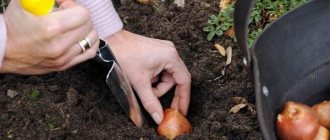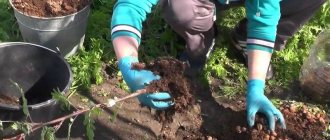When growing garden canna in your garden plot, you need to understand that this is a tropical plant. Overwintering in open ground kills heat-loving buds. And to get rid of the need to buy new planting material every year, it is much easier to save your own.
There are some subtleties in how to store cannas in winter. This means digging without waiting for frost, proper preparation and placement of rhizomes in a suitable place. There are at least three storage methods to grow a southern beauty with large leaves and powerful inflorescences in the spring.
Digging cannas
Cannas are a tropical plant, so freezing winter temperatures can be detrimental to them. In this regard, in order to preserve the cannas until spring, they are dug up in the fall and returned to their original place in the spring.
However, not all gardeners will have to dig up the crop. For those who live in the southern regions (the soil temperature in winter does not drop below -5°C), it will be enough to cover the plant for the winter with spruce branches or a layer of pine needles, after cutting off the leaves and flower stalks to the base.
In regions where the soil temperature drops to -6°C or lower, the plant must be dug up. Moreover, this must be done before the first night frosts. Otherwise, the roots may freeze and begin to rot during winter storage. In the middle zone, the plant needs to be dug up in mid-September, and in the northern regions - already at the end of August.
Storing cannas after digging in the fall can be done in several ways:
- in boxes in the form of grown roots (in a cellar or basement);
- in a refrigerator;
- in a flower pot at rest;
- like a houseplant.
The preparation of the plant will depend on how the storage is carried out, but the digging will be done the same way in any case. This should be done on a dry sunny day. You should dig up the tubers with a shovel carefully so as not to damage them. In this case, it is better to leave the roots with a lump of earth so as not to deprive the plant of its usual soil composition.
How to dig cannes
As we have already found out, canna rhizomes must be dug up every autumn. How to do this correctly?
So, you must choose a dry and sunny day, carefully dig up the bush from all sides and take it out with a lump of earth . Next, all you have to do is remove the above-ground part (leaving 10-20 centimeters) and you can put it away for storage.
By the way! You can trim the stems before digging.
Interesting! Some gardeners recommend additionally cleaning the rhizomes from the soil (you can even rinse them with water), cutting off small roots and rotten parts, covering the cuts with brilliant green or crushed coal, treating (treating) with a fungicide, drying them well and only then putting them away for storage.
Why clear the earth? The fact is that the soil can be a source of infection, which means that your rhizomes may be affected by some disease (they may rot) during storage.
Storage in a cellar or basement
Cannas can be stored for the winter in a cellar or basement. The room will need to be prepared first: take out everything unnecessary, clean the walls and floor of mold and treat it with an antifungal compound. These measures will help protect the plant from mold, which can destroy it.
In addition, the premises must meet the following requirements:
- constant air temperature not lower than 0 °C;
- air humidity 90−95%.
The plant itself should be cut off during digging, leaving a short stem 10-15 cm long. Cuts can be treated with a fungicide to protect the cannas from diseases. Next, preparing the tubers will consist of drying them; for this, after digging, they are left in the open air (under a canopy) for 3-4 days.
When the roots are dry, they need to be placed in wooden boxes, sprinkled with peat, sand, humus or sawdust for better preservation and transferred to the cellar.
During storage, it is worth checking the plants once a month and, if necessary, moistening them with a spray bottle (soil humidity should be about 50%). In addition, you need to carefully monitor so that rot does not appear. If it appears, you need to cut off all the affected areas and sprinkle the cut areas with charcoal or treat them with iodine.
Plant preparation
Cannes should be prepared for the upcoming winter immediately after the first frost arrives, that is, at the end of September or beginning of October, depending on weather conditions in a particular region. To carry out this procedure, it is necessary to carefully trim the stems, leaving about 10-15 centimeters. Then the plants need to be kept in the ground for a few more days, generously treating the cut areas with fungicide. This preventive measure will protect the crop from the emergence of various diseases.
You may be interested in:
What perennial flowers can be planted at the dacha? Perennials, of course, usually predominate in any garden, and this is understandable - there is less fuss with them, depending on the planting material...Read more...
Next, the tuber needs to be dug out of the ground, cleaned of any remaining soil and placed under a canopy - there it will dry for another 3-4 days. There is no need to completely get rid of the soil; just gently shake off the roots. A separate group of summer residents is of the opinion that it is better to store cannas together with a clod of earth, but this is not a necessary condition.
As the roots dry, the tubers can be brought into the basement or cellar, placed in a box. To achieve maximum protection, they can be sprinkled with humus, peat, sawdust or sand. It is recommended to maintain the humidity level at 50−60%.
During the entire storage period, you need to constantly monitor the condition of the flowers. The root system should be assessed every four weeks. If the roots are dry, it is better to spray the soil with a spray bottle. If there are rotten areas, you will have to get rid of the affected tubers, otherwise putrefactive processes will quickly appear on healthy tubers. If the lesions are minor, they need to be completely cut off to healthy tissue and then treated with iodine or charcoal.
It is also necessary to inspect neighboring tubers, as there is a possibility that they are also affected by the disease. In the end, it remains to determine the cause of the rotting. It is often associated with a sharp jump in temperature or high humidity. By eliminating this problem, you can successfully preserve flowers until spring.
At home
If you don’t have a cellar or basement, you can preserve cannas in the winter at home. This can be done by leaving the tubers dormant or growing them as a house plant.
Storing in the refrigerator
The refrigerator is perfect for storing flowers. To prepare the plant, the stems must be trimmed, leaving 10-15 cm, and the sections must be treated with iodine. In this case, the roots should be cleared of soil by washing them in running water. After this, the roots need to be placed for a day in a solution of potassium permanganate (or a special disinfectant solution suitable for plants).
Next, the tubers should be thoroughly dried, wrapped in damp newspapers and placed in plastic containers. Storage containers do not need to be airtight, so you need to make holes in them in advance.
Once a month, cannas placed in the refrigerator must be inspected for rot and drying out.
In a flower pot
Flower pots can be used to store canna flowers in winter. In this case, a plant placed in a pot can be either at rest or in a state of growth. In the first case, the cannas are placed in a container of a suitable size and placed on a glazed balcony, loggia or veranda. But it is worth considering that in these rooms the air temperature must be maintained within the range from +12 to +15°C. It is enough to water the plant once every two weeks (be sure to ensure that the soil is not waterlogged).
To grow cannas in winter as a home flower , it should be placed in a spacious pot. When digging, you need to cut off only the dry parts of the leaves and stem. Garden soil, to which the plant is accustomed in the summer, is suitable as a substrate. Or you can use a mixture of sand, sawdust and peat, taken in equal proportions.
The culture loves sunlight, so it should be placed on a window on the south or east side, then the plant will bloom until mid-December. Cannas should be watered regularly and fed once a month with mineral fertilizers.
Flower pot
If you want to store flowers as a houseplant, you need to prepare pots of a suitable size. This method allows you to keep cannas both in a state of rest and in active growth. The first option involves moving the crop to a glazed balcony, veranda or loggia. The main thing is that this room has a stable temperature within +12 - +15 degrees Celsius. Water the plant no more than once every two weeks. Excessive soil moisture should not be allowed, as this may lead to the development of putrefactive processes.
If you want to enjoy canna flowering even in winter, you need to place the flower in a spacious pot, and during pruning, get rid of only dry and dead parts of the crop. At the bottom of the container used, you need to place fertile garden soil in which the plant was grown in the summer. You can also prepare a suitable mixture of sawdust, peat and sand, combined in equal proportions.
The culture needs abundant sunlight , so it is better to place it on a south or east window. In this case, the flowering period will last until mid-December. With this method of storage, the flower needs to be watered once a month, and also fertilized with appropriate fertilizers.
Preparing for spring planting
Before planting cannas in their original place in the spring, they should be prepared. If the plant is in a pot, then at the beginning of April you need to start hardening it off. To do this, during the day it should be taken out to an open terrace or balcony, and put back into the room at night.
If the plant was stored in a cellar , basement or refrigerator, then at the beginning of April the roots need to be removed and divided, focusing on the number of new shoots (each part should have two sprouts or two buds that will produce new shoots).
For each received part you need to prepare a temporary pot . It is filled with a substrate consisting of black soil, sand and peat, taken in equal parts. The soil in the pot needs to be watered with mineral fertilizer.
Pots with flowers planted in them should be placed in a greenhouse or warm room. Cannas are transplanted into open ground in early June.
Spring planting
If the flowers have successfully overwintered in the cellar or apartment, and the spring season is just around the corner, this means that it is time to start preparing the plants for planting outside. If they overwintered in a pot, then at the beginning of April they can be hardened off. To do this, the culture is taken out onto an open terrace or balcony, and put back into the room at night. When stored in a cellar, basement or refrigerator, the roots are taken out and divided taking into account the number of new sprouts (each element must have two sprouts or healthy buds).
The final movement of cannas into open ground occurs at the beginning of the summer season. In order for flowers to successfully take root in new conditions and provide the gardener with abundant flowering, when choosing a planting site, preference should be given to slightly shaded or sunny areas with a good fertile substrate.
Immediately before planting, a hole is dug and then water is poured into it. Only after this can you start planting the flower. If you follow the basic rules, the lush flowering of this colorful exotic plant will begin in July or August. The time of appearance of flowering elements depends on both climate conditions and varietal characteristics.
The process of storing cannas in winter is not difficult. You can save such flowers from frost in the cellar, on a glassed-in loggia, attic, in a city apartment, and even in the refrigerator. There are a lot of possibilities and ways to protect crops from winter frosts. All that remains is to decide on the appropriate option and start preparing. The success of wintering depends on the correct implementation of preparatory procedures, selection of a suitable location and regular inspections. After following all the rules, you can be sure of lush and beautiful flowering when the warm season returns.
Checking the storage area
Cannes can be stored in a dry cellar or basement. The main thing is that the following conditions are met in the room:
- the air temperature should not fall below zero degrees;
- humidity should be at 90-95%;
- the room must be clean, free from fungus and mold;
- having easy access so that you can regularly go into it and check the condition of the plants.
If at least one of these points is not observed, then storing flowers in such a room may be in jeopardy. Fungus and mold pose a particular danger to plants. It can quickly spread throughout the room. If mold affects the roots of a plant, then it will most likely not be possible to save it.











